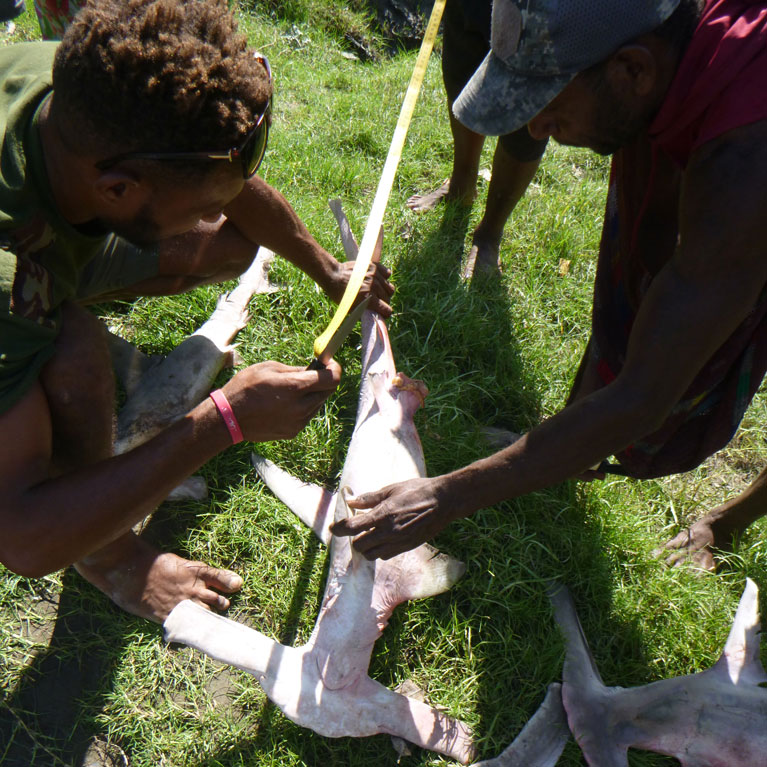Keeping watch on winghead sharks in Papua New Guinea
Yolarnie is working to provide information to bolster fisheries management of the Endangered winghead shark in the Kikori Delta of Papua New Guinea. The significant winghead shark population here is vulnerable to the swim-bladder fishery that has taken root in the turbid waters of the Kikori Delta since 2010. Fish like the scaly jewfish and barramundi are targeted for their swim bladders, but Yolarnie is monitoring the fishing nets because they are a key source of winghead shark mortality. She’s hoping her findings will be taken up by the National Fisheries Authority to institute a management plan for swim-bladder fisheries.
I grew up near the sea, in a tropical town in Papua New Guinea, and snorkelling among the corals was one of my favourite activities. When I discovered that you could get a job involving the ocean and corals, I decided this was what I wanted to do. So I went to university to pursue a career as a marine biologist. After I graduated, my life went in a very different direction in that I travelled to the Kikori River, a large river in southern Papua New Guinea, to study a freshwater turtle in decline. I was offered...
Assessing the vulnerability of the winghead shark to exploitation in southern Papua New Guinea
Our primary objective is to collect information about the age and growth of the winghead shark Eusphrya blochii and to continue monitoring the catch rate in the Kikori Delta of Papua New Guinea so as to inform better management of fisheries and the species.
Listed as Endangered on the IUCN Red List, the winghead shark is disappearing and reports worldwide indicate that it is vulnerable to fishing pressure. No information about its life history is available to inform management. In Southern PNG there is a substantial population of winghead sharks, but it is being heavily exploited for the sharks’ swim bladders. To protect the species effectively, we need to learn more about its life history and document its exploitation by fisheries.
Inshore fishing in Papua New Guinea has shifted towards targeting fishes’ swim bladders for a high-end dried product in the east Asian market. Although the most prized swim bladders are generally those of croakers (Sciaendiae), which can be worth up to US$25,000 per kilogram (dried weight) in end-user markets, most large-bodied estuarine fish species are also highly valued. Papua New Guinea has little data about inshore and riverine fisheries and lacks legislation for them, so swim-bladder fisheries are effectively unmanaged.
In the extensive turbid habitat of the Gulf of Papua, a number of species are available to be targeted by the swim-bladder fishery. Since 2015, this fishery has developed rapidly in the Kikori Delta, and as the local value of swim bladders has grown, various legal and illegal market chains have emerged. At present there is neither a management plan for the swim-bladder fishery nor enough known about social and biological factors to inform a management plan. Preliminary data recorded over six months indicate that the winghead shark is the most heavily caught species in the fishery. In one location in the western Kikori Delta, where only the elasmobranch catch was being monitored, 1,112 specimens were recorded, of which the 862 (78%) winghead sharks dominated the catch and a range of sizes were landed. Considering that these data relate to just one fishing community (there are at least 10 other major fishing communities in the region), extrapolations quickly indicate that the winghead shark is exposed to very high mortality from fishing.
The winghead shark is globally Endangered. Its local population is probably centred in the north-western Gulf of Papua, where the swim-bladder fishery occurs. There is currently no age or growth information for the species and it is not clear how vulnerable it is to existing fishing pressure. Furthermore, fundamental information about the catch rates of both target and non-target species is needed to assist the National Fisheries Authority as it deliberates over management options.
- To collect age and growth data about the Endangered winghead shark and thus contribute to life history information about the species. The data collected will assist in the management of the species and ultimately efforts to protect and conserve it.
- To continue collecting data relating to the bycatch and life-history characteristics of Critically Endangered sawfish, four species of which have been documented in our area.
- To continue the monitoring of fishing nets and their catch rates for the swim-bladder fishery, which is currently the greatest source of mortality for the winghead shark and other sharks and rays of the Kikori Delta.
- To provide essential information to the National Fisheries Authority, in the form of data collected from shark and ray interactions with the swim-bladder fishery, as it deliberates over a swim-bladder management plan for Papua New Guinea.


